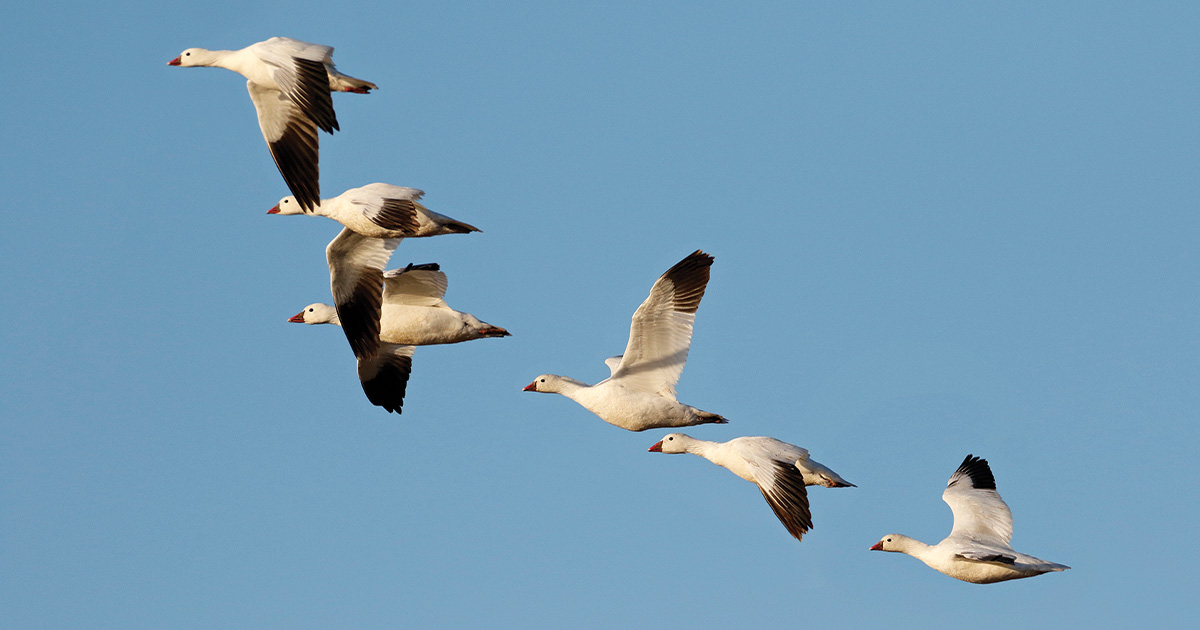Migration Alert: Central Flyway Hunters Brace for Speedy Spring Migration
Feb. 13, 2024 – Central Flyway – Light Goose Conservation Order
Feb. 13, 2024 – Central Flyway – Light Goose Conservation Order

With the table set for a fast-paced migration of light geese through the northern reaches of the Central Flyway, hunters are readying themselves for what could be a Light Goose Conservation Order unlike any other in recent memory. Here’s a look at current habitat conditions and a potential silver lining to the challenges awaiting hunters this spring.
One look at a snow cover map of Nebraska, South Dakota, and North Dakota tells you everything you need to know about the obstacles standing in the way of light geese currently moving north from their wintering grounds: Quite simply, there are none. Warm temperatures have largely erased snow from the region, and the slivers of open water on the region’s rivers, lakes and wetlands are growing larger by the day. These conditions are most certainly unusual for the second week of February, and they are allowing light geese to arrive weeks ahead of schedule in this part of the Central Flyway.
“Snow geese are building in numbers along the Missouri River in the southeast corner of the state, and we’re also seeing birds move north through the James River Valley,” reports Rocco Murano, head waterfowl biologist for the South Dakota Game, Fish and Parks. Murano notes that the Light Goose Conservation Order in South Dakota officially begins on February 19, and that the department’s webpage will be posting updates on the light goose migration in the coming weeks.
“There is a chance for a bit of snow in parts of South Dakota later this week, but I don’t expect it to last long,” Murano says. “I cannot recall another winter when the weather conditions have been so extremely mild across such a large part of the Central Flyway in mid-February. There is nothing to stop the geese from moving north, at this point, and it will take a significant amount of snow to put the brakes on the migration.”
Murano says that hunters won’t have much of a choice but to add a fast-paced migration to the list of challenges that they typically encounter during the Light Goose Conservation Order.
But unlike dealing with muddy field conditions and smart, wary geese, there may be a silver lining to the pace of the migration this spring.
“One of the biggest challenges that you can have in the spring is competing with big groups of real birds feeding and roosting in an area, and that is typically what you run into during those years when you have a hard line of ice and snow holding birds back,” says veteran South Dakota guide and hunter Ben Fujan. “It is not easy to make your decoy spread stand-out when there are huge groups of real birds in an area. I’m guessing that we won’t have to battle that this year, and that’s probably a good thing.”
Fujan believes that because the conditions will keep adult geese – which are eager to reach the breeding grounds and notoriously more difficult to hunt – moving through the region, those decoy-friendly juvenile birds found at the tail-end of the migration will be able to move through at their own pace, extending opportunities for hunters.
There isn’t anything that hunters can do about the weather, Fujan concludes, but the hardened rules of hunting snow geese in the spring remain: The geese will still be tired and hungry from migrating north, and they will still need to stop to eat and rest before pushing on toward the breeding grounds.
“Get out there when you can, and keep an eye out for any weather that may cause a reverse migration of birds back from the north,” Fujan says. “There is a lot that can happen in the next few weeks.”
Stay up to date with the latest migration information.